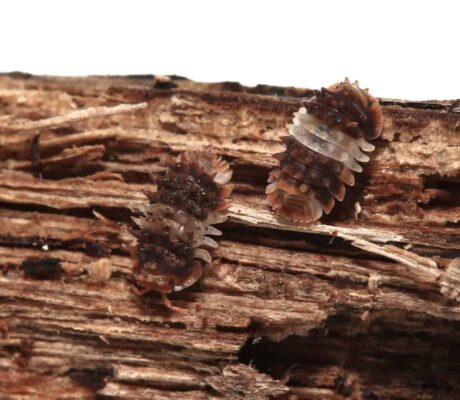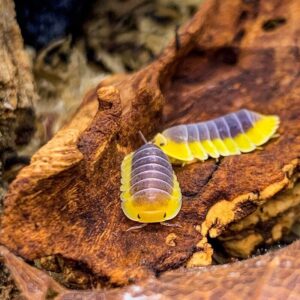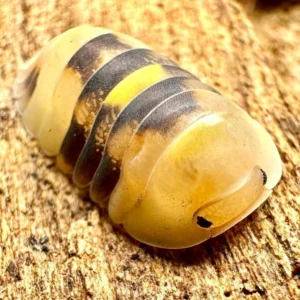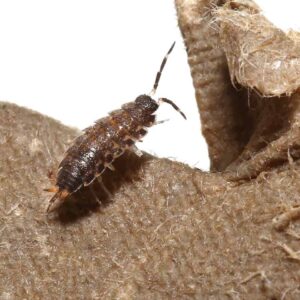Thai Spikey Isopod For Sale
$39.99
WE HAVE THAI SPIKEY ISOPOD FOR SALE HERE ARE SOME HIGHLIGHTS:
Description
Thai Spikey Isopod
The Thai Spikey Isopod, scientifically known as Merulanella siamensis, is a captivating species that has garnered interest from biologists and enthusiasts alike. This unique isopod stands out due to its distinctive physical characteristics and remarkable adaptations. Found predominantly in the forests of Thailand, it has adapted to its environment in ways that make it a subject of fascination and study.
One of the most notable features of the Thai Spikey Isopod is its armored exoskeleton, which is adorned with spikey protrusions. These spikes not only serve a defensive purpose, warding off potential predators, but also contribute to its peculiar appearance. The isopod’s body is segmented, with each segment bearing a pair of legs, facilitating its movement across the forest floor. Ranging in color from earthy browns to vibrant greens, the Thai Spikey Isopod can blend seamlessly into its surroundings, providing an excellent example of cryptic coloration.
Another intriguing aspect of this isopod is its behavior and habitat preferences. The Thai Spikey Isopod is typically found in moist, decaying leaf litter, where it plays a crucial role in the decomposition process. By breaking down organic matter, it contributes to nutrient cycling and soil health, highlighting its ecological significance. Its nocturnal habits further add to its elusive nature, making daytime sightings relatively rare and all the more exciting for those lucky enough to encounter it.
Understanding the Thai Spikey Isopod’s unique features and behaviors not only enriches our knowledge of biodiversity but also underscores the importance of preserving its natural habitat. As we delve deeper into the world of this remarkable creature, we uncover the intricate balance of ecosystems and the myriad ways in which each species, no matter how small, contributes to the greater environmental tapestry.
The Thai Spikey Isopod, a captivating crustacean, primarily inhabits the lush and diverse ecosystems of Southeast Asia. Its natural habitat predominantly includes moist, tropical forests where humidity levels are high, ensuring an optimal environment for its survival. These isopods are often found beneath decaying leaf litter, under logs, and within the rich, organic soil that characterizes these regions. The dense vegetation and abundant organic matter provide an ideal microhabitat, offering both food sources and protection from predators.
Geographically, the Thai Spikey Isopod is distributed across various parts of Thailand, with notable populations in regions such as the Khao Sok National Park and the tropical rainforests of Northern Thailand. Their presence in these areas underscores their preference for undisturbed, pristine environments where human activity is minimal. Additionally, the isopods are adapted to thrive in environments with stable temperatures and high humidity, which are critical for maintaining their physiological processes.
Beyond Thailand, similar species of spikey isopods can be observed in other parts of Southeast Asia, although the Thai Spikey Isopod is unique in its specific adaptations to local conditions. These crustaceans contribute significantly to the ecological balance of their habitats by participating in the decomposition process, breaking down organic matter, and recycling nutrients back into the soil. This role is vital for maintaining the health and sustainability of the forest ecosystems they inhabit.
In terms of environmental conditions, the Thai Spikey Isopod requires a habitat with consistent moisture levels. Seasonal variations in rainfall can influence their distribution, with populations often peaking during the wet season when conditions are most favorable. The interplay between the isopod’s biological needs and the environmental attributes of their habitat showcases the intricate balance of nature, underscoring the importance of preserving these delicate ecosystems to ensure the survival of such unique and fascinating species.
Behavior and Diet
The Thai Spikey Isopod, an intriguing crustacean species, exhibits unique behavioral patterns and dietary habits that set it apart from other isopods. Primarily nocturnal, this species becomes active during the night, foraging and engaging in various social behaviors. The isopod’s nocturnal nature aids in evading predators, leveraging the cover of darkness for safety.
In terms of diet, the Thai Spikey Isopod is primarily a detritivore, feeding on decaying organic matter. This diet includes decomposing plant material, leaf litter, and dead insects, which provide essential nutrients. Occasionally, the isopod may also consume fungi and algae, diversifying its nutrient intake. This detritivorous diet plays a critical role in the ecosystem, as it contributes to the decomposition process and nutrient cycling, maintaining soil health.
Feeding strategies of the Thai Spikey Isopod involve scavenging and foraging through the forest floor. Using its well-adapted mouthparts, the isopod can efficiently break down and ingest decomposing matter. Its antennae serve as sensory tools, guiding the isopod to potential food sources in its habitat.
Regarding unique behaviors, the Thai Spikey Isopod displays remarkable defensive mechanisms. When threatened, it can curl into a tight ball, a behavior known as conglobation, which protects its soft underbelly and presents its spikey exoskeleton to potential predators. This defense strategy is effective against various predators, including birds and small mammals.
Mating rituals of the Thai Spikey Isopod are also noteworthy. Males engage in a courtship display, involving specific movements and antennal touches to attract females. Once a female is receptive, mating occurs, and the female subsequently carries fertilized eggs in a brood pouch until they hatch, ensuring the young’s safety during development.
In summary, the behavioral patterns and dietary habits of the Thai Spikey Isopod illustrate its adaptability and ecological significance. Its nocturnal activities, detritivorous diet, and unique defensive and mating behaviors highlight the complexity and fascinating nature of this species.
Reproduction and Life Cycle
The reproductive habits and life cycle of the Thai Spikey Isopod are intricate and fascinating, contributing significantly to their population dynamics. The life cycle of this unique crustacean begins with the female laying eggs. These eggs are typically deposited in a secure environment, often hidden within the substrate to protect them from predators and environmental hazards. The incubation period for the eggs can vary depending on the environmental conditions, such as temperature and humidity, but it generally lasts several weeks.
Once the eggs hatch, the young isopods, known as juveniles, emerge. These juveniles resemble miniature versions of the adults but lack the full development of their characteristic spikey armor. During this stage, they are highly vulnerable and rely on their ability to blend into their surroundings to avoid predation. As they grow, they undergo a series of molts, shedding their exoskeleton and developing new, larger ones. This molting process is crucial for their growth and continues until they reach full maturity.
The reproductive rate of the Thai Spikey Isopod is noteworthy. Under optimal conditions, a single female can produce several broods in her lifetime, each consisting of numerous offspring. This high reproductive rate is a key factor in the species’ ability to maintain and expand its population. However, it is also balanced by the natural mortality rates of the juveniles and the challenges posed by their environment.
Interestingly, the breeding practices of the Thai Spikey Isopod include a level of parental care that is uncommon among many crustaceans. Females are known to guard their eggs and newly hatched juveniles, providing them with an added layer of protection during their most vulnerable stages. This behavior not only increases the survival rate of the offspring but also ensures the continuation of the species.
Overall, the reproductive habits and life cycle of the Thai Spikey Isopod are integral to understanding their population dynamics. The combination of high reproductive rates, parental care, and the challenges of juvenile development creates a complex and adaptive life strategy that allows these fascinating creatures to thrive in their natural habitats.
Adaptations and Survival Mechanisms
The Thai Spikey Isopod, scientifically known as Armadillidium vulgare, possesses a myriad of adaptations that ensure its survival in the diverse and often challenging environments of Southeast Asia. One of the most striking physical adaptations of this isopod is its spikey exoskeleton. The exoskeleton is not just a protective layer; the spikes serve as a deterrent against predators, making the isopod a less appealing target. This feature is a pivotal aspect of its defense strategy, providing both physical protection and a psychological deterrent.
In addition to its formidable exterior, the Thai Spikey Isopod exhibits a range of behavioral adaptations that bolster its survival. These isopods are primarily nocturnal, which reduces their exposure to predators during daylight hours. By foraging and engaging in other activities under the cover of darkness, they significantly lower their risk of predation. Furthermore, their ability to roll into a tight ball—a behavior known as conglobation—offers an added layer of defense, protecting their vulnerable underbelly and presenting an armored exterior to potential threats.
Physiological adaptations also play a crucial role in the survival of the Thai Spikey Isopod. These creatures are equipped with specialized respiratory structures called pleopods, which allow them to efficiently extract oxygen from the humid air in their subterranean habitats. This adaptation is particularly beneficial in the moist and often oxygen-depleted environments they inhabit. Moreover, their ability to secrete antimicrobial compounds helps them avoid infections and thrive in environments teeming with microorganisms.
Overall, the Thai Spikey Isopod’s array of physical, behavioral, and physiological adaptations underscore its remarkable ability to navigate and endure within its ecosystem. These multifaceted survival mechanisms not only illustrate the isopod’s resilience but also highlight the intricate complexities of adaptation in the natural world.
Role in the Ecosystem
The Thai Spikey Isopod plays a significant role in its native ecosystem, contributing to both the balance and health of its environment. As a detritivore, this isopod primarily feeds on decaying organic matter, such as leaf litter and decomposing plant materials. By breaking down these substances, the Thai Spikey Isopod aids in nutrient cycling, returning essential elements like nitrogen and phosphorus to the soil. This process enriches the soil, promoting plant growth and supporting a diverse range of flora.
Moreover, the Thai Spikey Isopod serves as a vital food source for various predators, including birds, amphibians, and small mammals. Its presence in the food web underscores its importance in maintaining the biodiversity of the ecosystem. Predators rely on the isopod for sustenance, and any significant decline in its population could disrupt the balance, impacting those species that depend on it for nutrition.
In addition to its role as a decomposer and prey, the Thai Spikey Isopod also interacts with other invertebrates and microorganisms within the ecosystem. These interactions can influence the population dynamics of other species, promoting a more stable and resilient environment. For instance, by consuming decaying matter, the isopod reduces the habitat for harmful bacteria and fungi, thereby helping to control the spread of disease within the ecosystem.
Furthermore, the burrowing activities of the Thai Spikey Isopod contribute to soil aeration. As these isopods tunnel through the ground, they create pathways that allow air and water to penetrate the soil, fostering a healthier root environment for plants. This action not only benefits plant life but also enhances overall soil structure, leading to improved water retention and reduced soil erosion.
Overall, the Thai Spikey Isopod’s various roles underscore its ecological significance. By participating in nutrient cycling, serving as prey, interacting with other species, and aiding in soil health, this isopod contributes to a balanced and thriving ecosystem.
Conservation Status and Threats
The Thai Spikey Isopod, scientifically known as Harpinia phuketensis, is a fascinating yet vulnerable marine crustacean found in the coastal waters of Thailand. Its conservation status has been a growing concern among marine biologists and conservationists. Currently, the Thai Spikey Isopod is classified as “Near Threatened” on the International Union for Conservation of Nature (IUCN) Red List. This status indicates that while the species is not yet endangered, it is close to qualifying or is likely to qualify for a threatened category in the near future if the circumstances impacting its survival do not improve.
Population trends for the Thai Spikey Isopod have shown a worrying decline over recent decades. Several factors contribute to this downward trend, with habitat destruction being a primary cause. Coastal development, pollution, and the destruction of mangroves and seagrass beds, which serve as crucial habitats for these isopods, have significantly impacted their populations. Additionally, climate change has exacerbated these threats by altering sea temperatures and causing ocean acidification, further stressing the isopod’s natural habitat.
Another significant threat to the Thai Spikey Isopod is overfishing. As bycatch in commercial fisheries, these isopods are often unintentionally captured in large numbers, leading to a decline in their population. Furthermore, illegal and unregulated fishing practices contribute to the mortality rate of these creatures.
In response to these threats, various conservation efforts have been initiated. Marine protected areas (MPAs) have been established to safeguard critical habitats and provide a refuge for the Thai Spikey Isopod. Additionally, environmental organizations and research institutions are conducting studies to monitor population trends and understand the species’ ecology better. Public awareness campaigns are also being implemented to educate local communities about the importance of conserving marine biodiversity and promoting sustainable fishing practices.
Although challenges remain, these conservation measures offer hope for the future of the Thai Spikey Isopod. Continued efforts and collaboration among governmental bodies, non-governmental organizations, and local communities are essential to ensure the survival of this unique marine species.
Conclusion and Future Research
The Thai Spikey Isopod, with its unique morphological features and ecological roles, stands as a remarkable subject of study within marine biology. Throughout this blog post, we have delved into the species’ distinctive characteristics, habitat preferences, and the vital part it plays within its ecosystem. The Thai Spikey Isopod’s resilience and adaptability to its environment underscore its ecological significance, necessitating a deeper understanding of its biology and conservation needs.
Understanding the Thai Spikey Isopod’s role within its habitat provides insights into the broader marine ecosystem. This species’ presence affects sediment composition, nutrient cycling, and even the population dynamics of other marine organisms. As such, preserving this isopod contributes to maintaining the ecological balance. However, its habitat faces threats from climate change, pollution, and human activities, which could have far-reaching impacts on its population and, by extension, the ecosystem at large.
Future research is essential to uncover more about the Thai Spikey Isopod’s life cycle, reproductive habits, and interactions with its environment. Studies focusing on its genetic diversity could shed light on the species’ adaptability to changing conditions, offering clues for conservation strategies. Additionally, research into the impacts of environmental stressors on this isopod can inform policies aimed at mitigating harm and promoting sustainable practices in marine environments.
In conclusion, the Thai Spikey Isopod is not only fascinating due to its unique appearance but also crucial for the health of its ecosystem. Continued research and conservation efforts are imperative to protect this species and ensure the stability of the marine environments it inhabits. By advancing our understanding and fostering greater awareness, we can contribute to the preservation of the Thai Spikey Isopod and the intricate web of life it supports.






